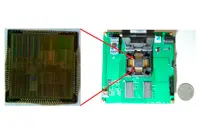Electronics News
Archive : 27 December 2015 год
 Scientists at the US Department of Energy's Lawrence Berkeley National Laboratory (Berkeley Lab) have developed a novel electrolyte for use in solid-state lithium batteries that is claimed to overcome many of the problems that plague other solid electrolytes while also showing signs of being compatible with next-generation cathodes.
Scientists at the US Department of Energy's Lawrence Berkeley National Laboratory (Berkeley Lab) have developed a novel electrolyte for use in solid-state lithium batteries that is claimed to overcome many of the problems that plague other solid electrolytes while also showing signs of being compatible with next-generation cathodes.
Berkeley Lab scientist Nitash Balsara said: "The electrolyte is compliant, which means it can readily deform to maintain contact with the electrode as the battery is cycled, and also has unprecedented room temperature conductivity for a solid electrolyte."
The electrolyte carries electrical charge between the battery's cathode and anode and in most commercial batteries is liquid. Researchers are striving to develop a battery with all solid components, as it would likely perform better, last longer, and be safer.
The two kinds of solid electrolytes each come with their own set of issues. Polymer electrolytes don't conduct well at room temperature and need to be heated up. Ceramic electrolytes, on the other hand, do conduct well at room temperature but require a great deal of pressure to maintain contact with the electrodes.
The new material the researchers developed was made by taking particles of glass, attaching perfluoropolyether chains to the surface of the particles, adding salt, and then making a film out of these components. By tuning the polymer-to-glass ratio, they were able to come up with a compliant electrolyte with high conductivity at room temperature and excellent electrochemical stability.
Although the conductivity is not as good as that of a liquid electrolyte, being about 10 to 15 times lower, "it's probably good enough for some applications," Balsara said. "We don't necessarily need to match a liquid electrolyte because nearly all of the current in the hybrid electrolyte is carried by the lithium ion. In conventional lithium electrolytes only 20 to 30% of the current is carried by the lithium ion. Nevertheless, it is likely that playing around with different glass compounds, particle size, and length and concentration of the polymer chains will result in improved conductivity."
The researchers also demonstrated that their hybrid electrolyte should be stable with two of the most promising next-generation cathode candidates that are being developed, sulphur and high-voltage cathodes such as lithium nickel manganese cobalt oxide.
"People would like to use 5V cathodes, but electrolytes that are stable against those 5V cathodes are not readily available," Balsara said. "We have demonstrated this electrolyte is stable at 5V, though we have not incorporated the hybrid electrolyte in the cathode yet."
Further experiments demonstrated that the hybrid electrolyte can be well suited to work with a sulphur cathode, which operates at a relatively low voltage but has the advantages of being high capacity and very inexpensive. A major failure mode in lithium-sulphur cells with conventional liquid electrolytes is the dissolution of intermediate compounds formed as sulphur in the cathode is converted to lithium sulphide into the electrolyte. However, the intermediates were found to be insoluble in the glass-polymer electrolyte.
"Although much work remains to be done, we believe that our work opens a previously unidentified route for developing hybrid solid electrolytes that will address the current challenges of lithium batteries," the researchers concluded.
Pic: Nitash Balsara, Berkeley Lab scientist
Author
Tom Austin-Morgan
Source: www.newelectronics.co.uk
 Researchers from Zhejiang University and Hangzhou Dianzi University, China have developed the Darwin Neural Processing Unit (NPU), a neuromorphic hardware co-processor based on Spiking Neural Networks (SNN), fabricated by standard CMOS technology.
Researchers from Zhejiang University and Hangzhou Dianzi University, China have developed the Darwin Neural Processing Unit (NPU), a neuromorphic hardware co-processor based on Spiking Neural Networks (SNN), fabricated by standard CMOS technology.
Artificial Neural Network (ANN) is a type of information processing system based on mimicking the principles of biological brains, and has been broadly applied in application domains such as pattern recognition, automatic control, signal processing, decision support system and artificial intelligence. SNN is a type of biologically-inspired ANN that performs information processing based on discrete-time spikes. It is more biologically realistic than classic ANNs, and can potentially achieve much better performance-to-power ratio.
With the rapid development of the IoT and intelligent hardware systems, a variety of intelligent devices have become pervasive in today's society, providing services and convenience to user’s lives, but they also raise challenges of running complex intelligent algorithms on small devices.
The Darwin NPU aims to provide hardware acceleration of intelligent algorithms on these resource-constrained, low-power, small embedded devices. It has been fabricated by 180nm standard CMOS process, supporting a maximum of 2048 neurons, more than 4million synapses and 15 different possible synaptic delays. Darwin is claimed to be highly configurable, supporting reconfiguration of SNN topology and many parameters of neurons and synapses.
The successful development of Darwin demonstrates the feasibility of real-time execution of SNNs in resource-constrained embedded systems. Its potential applications include intelligent hardware systems, robotics and brain-computer interfaces.
Author
Tom Austin-Morgan
Source: www.newelectronics.co.uk

